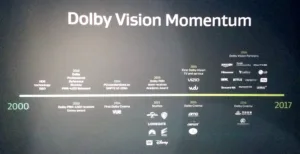Dolby used its CES suite at the Wynn to provide an update on its Dolby Vision and Dolby Atmos roll outs. New highlights included new Lenovo laptops with Dolby Vision – the first in this product category. News included the X1 Carbon and Yoga laptops with screens that offer 500 cd/m² of luminance and 100% of the Adobe color gamut (99% of P3). Next year, a higher luminance panel is planned with panels coming from both AUO and Innolux. The Yoga did come with an AMOLED panel but Lenovo has dropped that option apparently due to excessive power consumption from the display. The new versions are available now.
One area of the Dolby suite focused showcasing a number of TVs and Ultra HD Blu-ray players that now support Dolby Vision. As shown in the graphic below, eight major studios, seven leading streaming partners and 12 global TV brands now support Dolby Vision. Highlights in 2017 include Apple adding Dolby Vision to its ecosystem, inclusion of the Dolby Vision option in ATSC 3.0 and broadcast trials, plus the first set top box (Huawei), Blu-ray movie titles and games in Dolby Vision. It was a good year indeed.
Other areas focused on Dolby Atmos momentum including new devices and advancements in gaming; a living room all-Dolby experience and a “quality and consistency” demo that showed playback of Content on Dolby Vision HDR TVs vs. competitor TVs (Samsung) and the Dolby PRM reference monitor. The demo indeed showed a more consistent image in the DV sets for the clips they had prepared, as would be expected. They also showed the content on an iPhone X and Galaxy S8+.
With regards to competition with the other dynamic metadata standard, HDR10+, Dolby’s Giles Baker thinks it is not one or the other, that both have merits and both can co-exist. He said that Dolby Vision mastering always uses a colorist to create the metadata whereas HDR10+ uses an algorithm. This can mean a saving of time and money, said Baker, so some will find this appealing. But, he thinks having the colorist involved will always produce a better result.
Analyst Comment
What Baker said is only half true. Dolby Vision used in a broadcast environment does do automatic metadata creation for real time use. And, the HDR10+ workflow allows for a colorist to review and intervene in scenes where help is needed. (CC)

